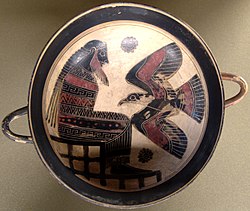Hetairia
| Sparta |
 Zeus on his throne with his eagle This article is part of the series: |
|
Great Rhetra Laws of Lycurgus Politeia |
|---|
|
List of Kings of Sparta Gerousia Ephorate Apella of the Damos Spartiates Perioeci Helots Agoge Syssitia |
|
Spartan army • Other Greek city-states • |
This article is part of the series:
Spartan Constitution
The syssitia (Classical Greek: τὰ συσσίτια ta syssítia) was, in Ancient Greece, a common meal for men and youths in social or religious groups, especially in Crete and Sparta, though also in Megara in the time of Theognis (6th century BC) and Corinth in the time of Periander (7th century BC).
The banquets spoken of by Homer relate to this tradition. Some reference to similar meals can be found in Carthage and according to Aristotle (Politics VII. 9), it prevailed still earlier amongst the Oenotrians of Southern Italy.
The origin of the syssitia is unknown; while Lycurgus certainly made use of the practice in Sparta, we do not know whether he introduced the practice or developed an existing one.
In Sparta, where the system was most evolved, they were also called pheiditia (φειδίτια, from ἔδω edō, to eat). The term is probably a corruption of φιλίτια philitia ("love-feast"), a word corresponding to the Cretan Hetairia. This was a daily obligatory banquet comparable to a military mess. Before the 5th century BC this ritual was also referred to as the ὰνδρεῖα andreia, literally, "belonging to men". Obligation was total; no person, not even the kings, could be absent without good excuse, such as performance of a sacrifice. Lesser excuses, such as being away on a hunt, implied a requirement to provide a present to the table (Smith 1870) .
...
Wikipedia
